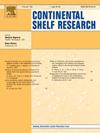A dead zone on the north-western Bay of Bengal's continental margin and its alarming impact on the distribution of demersal fishes
IF 2.2
3区 地球科学
Q2 OCEANOGRAPHY
引用次数: 0
Abstract
Hypoxia in the mesopelagic and demersal realms of marine ecosystems directly or indirectly affects fish population structure, community composition and ecosystem functioning. This may result in excess mortality or the emigration of organisms from the area, resulting in dead zones. The present study reports on a dead zone on the north-western Bay of Bengal's continental margin with no discernible fish catch. The phenomenon is associated with stratification, small residence time of suspended matter in the water column and weak vertical/horizontal mixing due to a retention area (and increased biological flux) observed in the region as a result of cooccurring warm and cold core eddies, resulting intense decompose activities in the regional bottom. As with similar ocean zones globally, dominance of a single species (Parascombrops pellucidus) around the zone's periphery (edge effect) is also reported which is attributed to their feeding patterns, locomotory characteristics, prey preferences and availability. The dead zone's seasonal occurrence indicates the influence of natural or anthropogenically induced climatic variability can even affect demersal/bottom-dwelling organisms. The present work discusses the drivers and implications of dead zones using in situ oceanographic and fishery data, remote sensing observations and model outputs.
孟加拉湾西北部大陆边缘的死区及其对底栖鱼类分布的惊人影响
海洋生态系统中下层缺氧直接或间接影响鱼类种群结构、群落组成和生态系统功能。这可能导致过高的死亡率或生物从该地区迁出,造成死区。目前的研究报告了孟加拉湾西北部大陆边缘的一个死区,那里没有明显的渔获。这一现象与分层、悬浮物在水柱中停留时间短以及由于冷暖核心涡旋共同发生而在该区域观察到的滞留面积(和生物通量增加)导致的弱垂直/水平混合有关,从而导致区域底部的强烈分解活动。与全球类似的海洋区域一样,也报道了单一物种(Parascombrops pellucidus)在区域外围(边缘效应)的优势,这归因于它们的摄食模式、运动特征、猎物偏好和可用性。死亡地带的季节性发生表明,自然或人为引起的气候变化的影响甚至可以影响海底/底栖生物。本工作利用现场海洋学和渔业数据、遥感观测和模式产出讨论了死亡区的驱动因素和影响。
本文章由计算机程序翻译,如有差异,请以英文原文为准。
求助全文
约1分钟内获得全文
求助全文
来源期刊

Continental Shelf Research
地学-海洋学
CiteScore
4.30
自引率
4.30%
发文量
136
审稿时长
6.1 months
期刊介绍:
Continental Shelf Research publishes articles dealing with the biological, chemical, geological and physical oceanography of the shallow marine environment, from coastal and estuarine waters out to the shelf break. The continental shelf is a critical environment within the land-ocean continuum, and many processes, functions and problems in the continental shelf are driven by terrestrial inputs transported through the rivers and estuaries to the coastal and continental shelf areas. Manuscripts that deal with these topics must make a clear link to the continental shelf. Examples of research areas include:
Physical sedimentology and geomorphology
Geochemistry of the coastal ocean (inorganic and organic)
Marine environment and anthropogenic effects
Interaction of physical dynamics with natural and manmade shoreline features
Benthic, phytoplankton and zooplankton ecology
Coastal water and sediment quality, and ecosystem health
Benthic-pelagic coupling (physical and biogeochemical)
Interactions between physical dynamics (waves, currents, mixing, etc.) and biogeochemical cycles
Estuarine, coastal and shelf sea modelling and process studies.
 求助内容:
求助内容: 应助结果提醒方式:
应助结果提醒方式:


